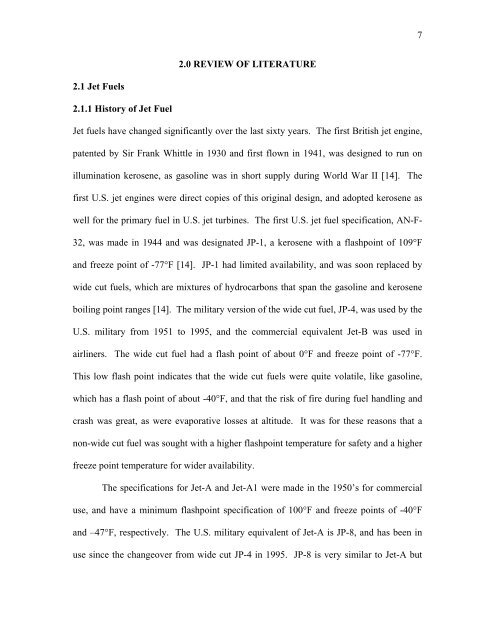Vaporization of JP-8 Jet Fuel in a Simulated Aircraft Fuel Tank ...
Vaporization of JP-8 Jet Fuel in a Simulated Aircraft Fuel Tank ...
Vaporization of JP-8 Jet Fuel in a Simulated Aircraft Fuel Tank ...
Create successful ePaper yourself
Turn your PDF publications into a flip-book with our unique Google optimized e-Paper software.
2.1 <strong>Jet</strong> <strong>Fuel</strong>s<br />
2.1.1 History <strong>of</strong> <strong>Jet</strong> <strong>Fuel</strong><br />
2.0 REVIEW OF LITERATURE<br />
<strong>Jet</strong> fuels have changed significantly over the last sixty years. The first British jet eng<strong>in</strong>e,<br />
patented by Sir Frank Whittle <strong>in</strong> 1930 and first flown <strong>in</strong> 1941, was designed to run on<br />
illum<strong>in</strong>ation kerosene, as gasol<strong>in</strong>e was <strong>in</strong> short supply dur<strong>in</strong>g World War II [14]. The<br />
first U.S. jet eng<strong>in</strong>es were direct copies <strong>of</strong> this orig<strong>in</strong>al design, and adopted kerosene as<br />
well for the primary fuel <strong>in</strong> U.S. jet turb<strong>in</strong>es. The first U.S. jet fuel specification, AN-F-<br />
32, was made <strong>in</strong> 1944 and was designated <strong>JP</strong>-1, a kerosene with a flashpo<strong>in</strong>t <strong>of</strong> 109°F<br />
and freeze po<strong>in</strong>t <strong>of</strong> -77°F [14]. <strong>JP</strong>-1 had limited availability, and was soon replaced by<br />
wide cut fuels, which are mixtures <strong>of</strong> hydrocarbons that span the gasol<strong>in</strong>e and kerosene<br />
boil<strong>in</strong>g po<strong>in</strong>t ranges [14]. The military version <strong>of</strong> the wide cut fuel, <strong>JP</strong>-4, was used by the<br />
U.S. military from 1951 to 1995, and the commercial equivalent <strong>Jet</strong>-B was used <strong>in</strong><br />
airl<strong>in</strong>ers. The wide cut fuel had a flash po<strong>in</strong>t <strong>of</strong> about 0°F and freeze po<strong>in</strong>t <strong>of</strong> -77°F.<br />
This low flash po<strong>in</strong>t <strong>in</strong>dicates that the wide cut fuels were quite volatile, like gasol<strong>in</strong>e,<br />
which has a flash po<strong>in</strong>t <strong>of</strong> about -40°F, and that the risk <strong>of</strong> fire dur<strong>in</strong>g fuel handl<strong>in</strong>g and<br />
crash was great, as were evaporative losses at altitude. It was for these reasons that a<br />
non-wide cut fuel was sought with a higher flashpo<strong>in</strong>t temperature for safety and a higher<br />
freeze po<strong>in</strong>t temperature for wider availability.<br />
The specifications for <strong>Jet</strong>-A and <strong>Jet</strong>-A1 were made <strong>in</strong> the 1950’s for commercial<br />
use, and have a m<strong>in</strong>imum flashpo<strong>in</strong>t specification <strong>of</strong> 100°F and freeze po<strong>in</strong>ts <strong>of</strong> -40°F<br />
and –47°F, respectively. The U.S. military equivalent <strong>of</strong> <strong>Jet</strong>-A is <strong>JP</strong>-8, and has been <strong>in</strong><br />
use s<strong>in</strong>ce the changeover from wide cut <strong>JP</strong>-4 <strong>in</strong> 1995. <strong>JP</strong>-8 is very similar to <strong>Jet</strong>-A but<br />
7
















